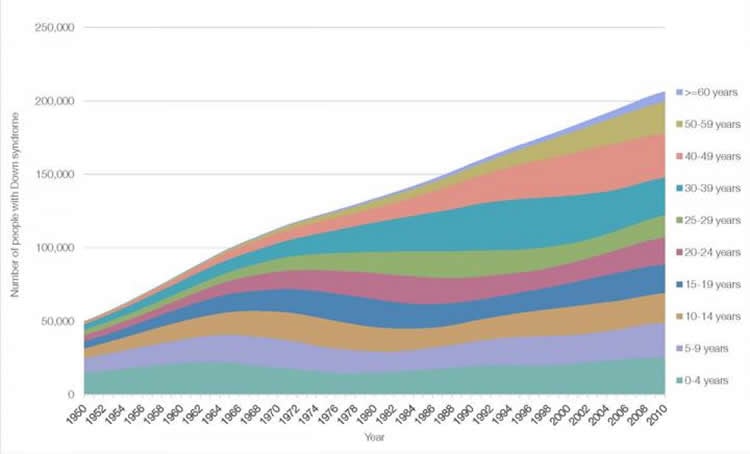Summary: Researchers track changes over decades and break down by racial groups the number of people diagnosed with Down syndrome.
Source: Mass General.
First study to track changes over decades and break down by racial, ethnic groups.
A new study has estimated, for the first time, the numbers of people with Down syndrome in the U.S., from 1950 until 2010. The total number arrived at by the investigation, which also is the first to break down its findings by ethnic group, is considerably less than previously estimated by several organizations.
“Almost every book, web page and research article about Down syndrome begins with what should be a simple fact – the number of people living with the condition in the U.S. – but what we found is that most of those statistics are gross overestimations of the actual data,” says Brian Skotko, MD, MPP, of MassGeneral Hospital for Children, co-director of the Massachusetts General Hospital Down Syndrome Program and senior author of the report receiving advance online publication in the journal Genetics in Medicine.
“With these new detailed estimates, we hope that policymakers can better appraise the impact of proposed legislation for this population, which has evolving racial and ethnic compositions, and nonprofit groups can better assess how representative their members are of the population at large. We also have established a crucial baseline to establish the effects, if any, of noninvasive prenatal testing for Down syndrome that has become available across the country,” he says.
Skotko and his co-authors – lead author Gert de Graaf, PhD, Dutch Down Syndrome Foundation, and Frank Buckley, Down Syndrome Education International/USA – have conducted several studies estimating numbers of individuals with Down syndrome nationwide or in areas like the state of Massachusetts and examining the effects of factors such as prenatal testing on total numbers. Other groups have estimated the prevalence of Down syndrome – numbers of individuals with Down syndrome per 10,000 population – at specific points in time, but this is the first to estimate how numbers have changed over a 60-year period.
The research team based their estimates on what they believe to be a larger and more accurate set of databases than previous studies have used – covering factors such as the numbers of children born with Down syndrome, how those numbers have been affected by changes in the overall population and by the availability of prenatal testing and elective termination, and how many individuals with the condition have survived to adulthood. The total number they arrived at for 2010 was 206,366 individuals with Down syndrome in the U.S., compared with almost 50,000 in 1950, including both those born in the U.S. and those who moved to the U.S. after being born in other countries. The population prevalence for 2010 was 6.7 per 10,000 for the overall population.

Broken down by ethnic and racial groups, the total 2010 estimates were 138,019 non-Hispanic whites, 27,151 non-Hispanic blacks, 32,933 Hispanics, 6,747 Asians/Pacific Islanders, and 1,527 Native Americans/Alaskans. For all ethnic and racial groups, numbers of individuals with Down syndrome were greater in younger age groups, but the growth over the years in the numbers of older individuals with Down syndrome reflects how the condition has changed from what was almost exclusively a childhood disability in the 1950s to one impacting a significant number of adults and older Americans.
Skotko explains, “Prior to the 1980s the medical community did not surgically correct the heart defects that were present in up to half the babies with Down syndrome. Now the surgeries are commonplace and ethically required, enabling children who would have died to lead thriving and healthy lives. Our growing understanding of how to treat other frequently co-occurring conditions – such as thyroid disease, obstructive sleep apnea, and leukemia – has also expanded longevity.”
An assistant professor of Pediatrics at Harvard Medical School, Skotko adds that their data on the ethnic diversity of the Down syndrome population will be valuable to organizations providing services to individuals with Down syndrome and their families. “Nonprofit support groups can now ask, for example, ‘How many non-Hispanic blacks with Down syndrome are in our membership, and are the numbers representative of the local and national populations?’ The number of Hispanics with Down syndrome has been growing incrementally, reflecting the growth of that population, while numbers among non-Hispanic whites have been slowing. Now we can begin to ask whether our resources, health care, and support systems are evolving to meet the needs of the changing population.”
Source: McKenzie Ridings – Mass General
Image Source: This NeuroscienceNews.com image is credited to G. de Graaf, F. Buckley, and B. Skotko.
Original Research: Abstract for “Estimation of the number of people with Down syndrome in the United States” by Gert de Graaf PhD, Frank Buckley and Brian G. Skotko MD, MPP in Genetics in Medicine. Published online September 8 2016 doi:10.1038/gim.2016.127
[cbtabs][cbtab title=”MLA”]Mass General. “Study Estimates Numbers of People With Down Syndrome in the US Since 1950.” NeuroscienceNews. NeuroscienceNews, 8 September 2016.
<https://neurosciencenews.com/down-syndrome-rate-us-5002/>.[/cbtab][cbtab title=”APA”]Mass General. (2016, September 8). Study Estimates Numbers of People With Down Syndrome in the US Since 1950. NeuroscienceNews. Retrieved September 8, 2016 from https://neurosciencenews.com/down-syndrome-rate-us-5002/[/cbtab][cbtab title=”Chicago”]Mass General. “Study Estimates Numbers of People With Down Syndrome in the US Since 1950.” https://neurosciencenews.com/down-syndrome-rate-us-5002/ (accessed September 8, 2016).[/cbtab][/cbtabs]
Abstract
Estimation of the number of people with Down syndrome in the United States
Purpose:
An accurate accounting of persons with Down syndrome (DS) has remained elusive because no population-based registries exist in the United States. The purpose of this study was to estimate this population size by age, race, and ethnicity.
Methods:
We predicted the number of people with DS in different age groups for different calendar years using estimations of the number of live births of children with DS from 1900 onward and constructing DS-specific mortality rates from previous studies.
Results:
We estimate that the number of people with DS living in the United States has grown from 49,923 in 1950 to 206,366 in 2010, which includes 138,019 non-Hispanic whites, 27,141 non-Hispanic blacks, 32,933 Hispanics, 6,747 Asians/Pacific Islanders, and 1,527 American Indians/American Natives. Population prevalence of DS in the United States, as of 2010, was estimated at 6.7 per 10,000 inhabitants (or 1 in 1,499).
Conclusion:
Until 2008, DS was a rare disease. In more recent decades, the population growth of people with DS has leveled off for non-Hispanic whites as a consequence of elective terminations. Changes in childhood survival have impacted the age distribution of people with DS, with more people in their fourth, fifth, and sixth decades of life.
“Estimation of the number of people with Down syndrome in the United States” by Gert de Graaf PhD, Frank Buckley and Brian G. Skotko MD, MPP in Genetics in Medicine. Published online September 8 2016 doi:10.1038/gim.2016.127







